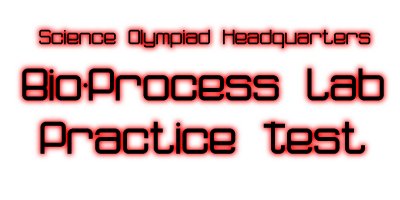

Please answer all questions completly by either filling in the blanks or circling the correct answers. No credit will be given for illedgible answers.
Name:_________________________________________
Team:_________________________________________
1.) A bond that involves the sharing of electrons between atoms such that each atom completes its outer electron shell is a _______________________________ bond.
2.) In the dissociation of NaCl in water:
A.) Water exerts forces that induce dissociation.
B.) Water is a passive solvent, accepting particles that dissociate because of their own internal forces.
C.) Water molecules lose hydrogen ions.
D.) Twice as many H+ ions are formed as Na+ ions.
E.) Equal numbers of H+ and Na+ are formed
3.) For each event listed below, select the property of water responsible from the list at the bottom.
_____ ionic and polar substances dissolve in water.
_____ freezing kills begonia plants.
_____ some insects can stand on the surface of a lakeA. cohesion
B. adhesion
C. polar molecules
D. specific heat
E. Higher density as liquid than as solid.
4.) Which of the following is not made up of hexose sugar substitutes?
A. Sucrose
B. Starch
C. Glycogen
D. Insulin
E. Celluose
5.) Which of the follwin statements is true about enzymes? Enzymes:
a.) are permaanently altered by the ractions they catalyze.
b.) make up the equilibrium of the reaction more favorable for the organisim.
c.) increase the energy of the reactant molecules.
d.) lower the energy of activation of a reaction
e.) lower the energy of the reaction's products.
6.) An area where the plasma membranes of neighboring cells adhere directly to each other is a(n):
a.) tight junction
b.) gap junction
c.) intermediary junction
d.) desomosome.
7.) Which of the following is not found in the cells of higher plants:
a.) Plasma membrane
b.) cell wall
c.) chloroplast
d.) ribosome
e.) centriole
8.) Does this reaction describe photosynthesis or respiration?
CO2+ H20 + C62H12O6 + O2
9.) Is the above reaction exergonic or endergonic?
10.) Is carbon oxidized or reduced as a result of the above reaction?
11.) Match the following
_____1. Location of clorophyll | a. stroma |
_____2. Location of enzymes for carbon fixation | b. chloroplast envelope |
_____3. Location of ATP synthease in chloroplasts | c. thylakoid membranes |
_____4. Location of H+ reservoir for ATP synthesis | d. thylakoid interior |
12.) Using the base-pairing rules, fill in the bases to be found on the RNA strand transcribed from the following DNA strand:
DNA A - G - G - C - C - T - G - C - T - T - A
RNA ________________________________
13.) List three differences between the structures of DNA and RNA.
___________________________________________________________________________
___________________________________________________________________________
___________________________________________________________________________
14.) Fertilization normally does not:
a.) Prevent more than one sperm entering the egg.
b.) Stimulate the egg to synthesize messenger RNA.
c.) Stimulate the egg to synthesize proteins.
d.) Contribute chromosomes to the zygote
e.) Stimulate cell division
15.) Both oogenesis and spermatogenesis involve equal division of the ____________________.
However, unequal division of the _________________ occurs during production of
___________________, whereas during production of __________________________,
this division is equal.
16.) Which bird is most evolutionarily successful?
a.) lays 9 eggs, 8 hatch, 2 reproduce
b.) lays 5 eggs, 5 hatch, 3 reproduce
c.) lays 7 eggs, 5 hatch, 4 reproduce
17.) True or False? In order for dominace to evolve, there must be a selection for genes at loci other than the one whose dominance is evolving.
18.) New species may originate by:
a.) doubling of the genetic material of a flowering plant.
b.) gradual accumulation of changes selected by for by local conditions
c.) a mutation that prevents reproduction with most other members of the species.
d.) all of the above
e.) only a and b
19.) Number the following structures and processes in the order in which they are believed to have evolved.
_________ respiration
_________ polymers
_________ water-splitting photosynthesis
_________ organic matter
_________ acquisition of intracellular organelles
_________ fermentation
20.) Place the following levels of the taxonomic hierarchy in decending order.
____ class
____ genus
____ family
____ order
____ phylum
____ kingdom
21.) Modern classification is based on:
a.) taxonomy
b.) phylogeny
c.) morphology
d.) fossils
e.) autotrophy
22.) A virus always contains:
a.) DNA, RNA, and proteins
b.) nucleic acids and lipids
c.) proteins and nucleic acid
d.) DNA and proteins
e.) nucleic acids, proteins, lipids, and carbohydrates
23.) For each statement below, tell whether it is true of lytic viruses (L), lysogenic viruses (LG), or both (B).
______ Many virus particles may be released from each host cell.
______ The host's DNA is destroyed by the virus.
______ Part of the host's DNA may be carried to a new host cell by the virus.
______ The viral DNA may be incorporated into the host's genome.
______ Viral proteins are synthesized on host ribosomes.
24.) Match each function below with the structure by which it is preformed:
____1. A foreign macromolecule that may endanger the body.
____2. Site of a filter that removes invaders from the body
____3. Long-lived cell that helps the body respond quickly to previously
encountered antigens
____4. Marcomolecule that aggluinates foreign molecules in the bloodstream
a. antibody
b. antigen
c. B lymphocyte
d. lymph node
e. memory cell
f. thymus gland
25.) State whether the species diversity of a community would be likely to increase (I) or decrease (D) in each of the following conditions:
______ increased frequency of disturbances.
______ extermination of a predator that preys on many other species.
______ partitioning of a shared resource among competing species.
Once you have completed this test, please wait for the proctor to collect your answer sheets.